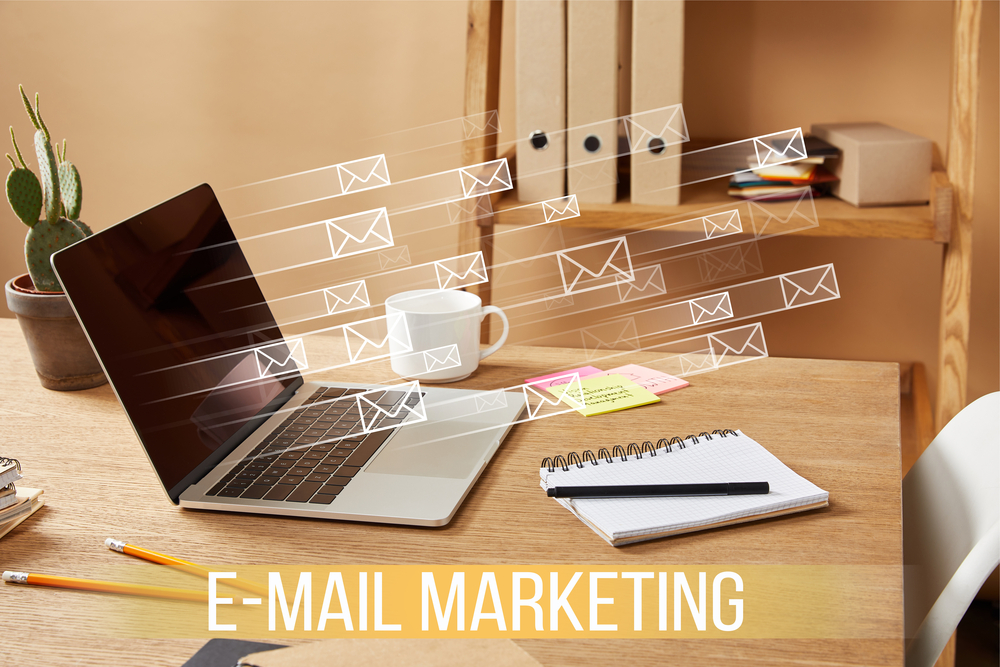How many times have you used chatGPT? Notice how I didn’t ask whether has been used. What about DALL-E2? Or Midjourney? Artificial Intelligence allows for every aspect of marketing to be improved and optimized.
Let’s not discuss each aspect of marketing. You can probably find an AI to do that. We’ll talk about email marketing strategies, something we are good at.
If you’re a true AI enthusiast, you didn’t miss the pun two sentences before and immediately thought about our holly mecca of new tools: theresanaiforthat.com. The image below shows all of the email solutions that we have available.
That’s right! It’s just writing. As we all know, creating effective email campaigns involves much more than simply writing a clever copy. There are audience segments that offer personalization. Template optimization, A/B tests, and other AI-powered features are also available.
You’re here to learn more about AI, right? Learn how AI can assist you in email marketing that goes beyond writing. Let’s buckle up and get started!
First things first…
How does AI even work?
It’s important to note that when we refer to AI in email, we are referring to a few different technologies, including machine learning (ML), natural language processing, deep learning, or email marketing automation.
AI technology is trained to analyze big datasets, work with data and make predictions. It also provides recommendations to improve personalization and segmentation in our digital marketing campaigns.
Artificial intelligence solutions that generate natural language (like the infamous ChatGPT), compute huge amounts of data, and then produce responses based on what they’re fed. The quality of your output directly depends on how much data you have provided.
ChatGPT was trained in 2020, so don’t expect to hear it talking about post-Covid society or the war in Ukraine.
Machine learning systems that are more advanced learn to make better predictions and take better decisions with time. Some can gather the latest or even real-time data to optimize further.
AI in Email Marketing
This is especially important for digital marketing campaigns and emails. Our automated messages should sound as natural and authentic as a human conversation. Therefore, the AI tool must have the most recent information about the user.
How can I get this information? Email databases already have quite sufficient data regarding your contact list. You can leverage AI for more personalized emails if you let AI crawl your site and collect zero-party data about user behavior during their customer journey.

AI email marketing: The state of the art
It’s been a long time since the future was not here. It may surprise you to learn that many of the processes which keep your email campaigns running are AI-based.
AI is already the faithful assistant of most email marketers!
You probably come into contact with them regularly.
- spam detection
- inbox delivery & filtering
- Smart Compose
- Send times optimized
- Product recommendations
- subject line generation
Let’s look more closely at how AI tools can improve our email marketing.
For recipients
Spam detection
Spam folders have been around since the 1990s. It had nothing to do with AI. You may remember that some aspects of AI are similar to automation. This is just one more example!
AI spam filters can be found in almost every email client today. They scan each message to identify any suspicious content or send patterns. They are responsible for preventing invalid email addresses from reaching your inbox and ensuring that you receive only the most relevant emails.
How does Gmail decide what messages from Uber Eats should be placed in the “Promotions folder” and which ones need to go into “Spam”, where they will never be seen again? It’s still a long road to sentiment analysis.
Even a simple application of AI software to validate emails can improve our perceptions about email deliverability, and the user experience we have with email clients like Gmail.
Filter by Category
Google (and other providers) are now taking on a greater responsibility to manage our inboxes and sort our mail for us.
It is still up to the user whether they want to use personalized labels. The algorithm can be a bit erratic and mistakenly label important emails as “Everything Else”, but it does it right 9 times out of 10. This saves us valuable time.
Google’s AI goes one step further and automatically sorts your emails into “Primary”, ‘Social’, and Promotions. Email marketers may not be able to maximize their inbox delivery, but the end users are sure to benefit!
For senders
Smart Compose
Google’s Smart Compose may not impress you if spend a few hours each week using Grammarly’s AI. But for the rest, it is a big deal.
It’s not about saving microseconds by pressing Tab instead of completing your outgoing message on your own. It’s more about matching the tone of your voice, recommending the appropriate polite sign-off, or reminding you to ask your recipient how they are doing before you share your unique offer.
For email marketers

What if you are in marketing, and you need to communicate with hundreds or thousands of individuals at once? Is AI still helpful?
It’s coming along.
Email send time optimization
Email marketing is a strategy that relies heavily on optimizing sending times, email scheduling, and other elements.
Instead of guessing when to send your product newsletter or searching online, you can pass the information to AI which will analyze the open rates and determine the best time to deploy the email.
Simple but highly effective.
Email product recommendations
is how product recommendations work, right? You did competitor analysis online, you browsed brands. A sneaky cookie, or another bot, recorded this information and now your competitors’ ads follow every click.
Email is a little different. Email is less intrusive than mobile push notifications or digital ads, and more difficult to miss than stealthy web push.
A business can only reach out to contacts who have explicitly consented to receive communications. It would then be possible to recommend products based on the embedded learning model in the structure of the website, dealing with zero-party information and not a third-party hand-off.
It may be more effective to embed AI recommendations in an email than just displaying them on the web browser.
Subject line generation
You can use AI to create email subject lines. What could be better than the ability to pass on the task of writing a subject line that converts to a robot that is optimized for delivery?
Writer’s block is no more. No more hours wasted trying to decide between “or ” as the first word of your sentence. No more drama!
AI: 5 ways to create better emails
It only gets better from here. Here are five new and better ways to integrate AI into your email strategy today, as well as 5 amazing AI tools that make it easy.

1. AI for Email Writing
Artificial intelligence has become more useful in the world of email marketing copywriting. It goes beyond writing a catchy subject line!
AI can assist you when it comes to copywriting.
- How to overcome writer’s blocks
- The summaries produced are of high quality.
- Tie your newsletter together by using an umbrella topic
- Create catchy subject line, preview message, and CTAs
- You should proofread your copy.
- Blog posts can be converted into newsletter sections
Copy.ai is the highlighted tool.
Copy.ai suits teams that are willing to delegate most of their copywriting to AI. The tool promises “premium results within seconds” for everything from emails to social media posts to blog posts. It says so.
Limitations:
It does take some time to create content. It’s not as long to create an email campaign, but it is longer than using a standard prompt. This is especially true if the results you want are not guaranteed.
I tried the suggested prompt but still got an error when exiting
2. AI for Inbox Management
I am terrible at managing emails. I have four providers, 775 notifications in my Gmail private account, and 4376 unread emails on my Outlook work account. Do I do anything to change that? Not quite.
Gmail and Outlook have tried to solve the problem to some extent. But we know there is no limit to perfection. Especially when your goal is to reach inbox zero each day. AI-powered inbox control is essential for busy marketers.
AI can assist with managing your inbox:
- Automatically assigning tags to email
- All your emails in one dashboard
- Create shared inboxes that are opened
- engaging your team in cooperation
- Manage sensitive customer data and accounts
- Save time by reading, writing, and sending email
The highlighted tool is on the Front
Front uses AI to make teams more efficient when it comes to email management. It enhances the customer experience by minimizing response times and allows teams to manage all their inboxes from a single dashboard.
Limitations:
It is a useful AI tool, but it doesn’t help you achieve “Inbox Zero” as promised. If you are looking for an AI tool that will filter through all your spam emails and only keep the good ones, this isn’t the right solution for you.
3. AI for customer feedback analysis
62 % of customers prefer to communicate via email over other channels. Email is a great way to send feedback requests. Where does AI fit in?
It’s no surprise that AI can gather customer data more efficiently than any human. AI can assist you with customer feedback analysis.
- Easy processing of qualitative responses
- Grouping results of surveys into categories (e.g. Positive and negative results
- Analyzing large amounts of data quickly
- Preparing survey questions for a particular group of recipients
- Designing and sending automated messages using feedback received
- Prioritizing solutions according to customer feedback
BetterFeedback is a highlighted tool.
The BetterFeedback tool is an AI-based qualitative analysis tool for customer feedback that reveals what customers “think, desire, and have problems with”.
It is designed to tackle the most important challenges in the analysis of complex customer feedback reports. This includes but is not limited to automated sentiment analyses, discovering trends on multiple channels, and grouping feedback from different channels into a single area.
Limitations:
BetterFeedback, a brand-new solution, is constantly working to improve its functionalities. One of the most important aspects of feedback analysis, advanced reporting, is still in development. The tool offers a 7-day free trial, but there is no perpetual free version, which could be discouraging for some users. They may not have enough time to explore all of the features.
4. AI for A/B Testing
You must have known this was coming if you dabbled in email marketing! split-testing, after all, is as integral to email best practices as creating strong subject lines.
It can also become quite monotonous and repetitive after a while. It can be very tiring to test whether ” is better than “, or even no emoji, in an email after email. Especially, since there are Performing multiple tests at depersonalizing split tests per segment, not per channel targeting with sophistication, Optimizing copy variants to improve conversion
abtesting.ai does not only apply to emails but is this a bad thing, anyway?
The platform optimizes your A/B tests across multiple channels and for various purposes. They’re also not afraid to use AI to maximize the effectiveness of your emails (or landing pages), whether it is a subject, copy, or catchy CTA.
Limitations There is more to email, than landings. It’s more direct, sophisticated, and touch-pointy. If you only want to optimize your emails, then this tool is not for you.
5. AI for predictive analytics
It’s not wrong to say that predictive analytics is dependent on AI in some way. It’s the statistical application that makes the model too complex for most email marketing.
You could also achieve great things through your email marketing campaigns if you were able to estimate recipients’ reactions. This is where AI comes into play.
AI can help you to predict email marketing using.
- Estimating and preventing unsubscription and churn
- Increasing the chances of conversion/purchase
- Determining the best time to send communications
- Data-driven insights can help you create customer retention strategies
- Preparing future campaigns using real-time metrics
- Smart segmentation allows you to send personalized emails
You must have read this article carefully and noticed that predictive analytics is in some way present in every application of AI for email marketing. It’s the most important thing that all of your AI-powered campaigns should have in common.
This is why will not have a single tool recommendation (well, sort of).
Instead, a word of caution: no one wants to be overwhelmed by dozens of digital platforms, SaaS, and annual subscriptions just to send an email. should find one AI-friendly email platform that can cover most of your needs.
GetResponse, for example, has launched an AI Email Creator. GetResponse offers a simple and fast way to help our users with every step of their email marketing campaign – from creating and converting subject lines to email layout design and natural language generation.
Are we expecting it to change how AI is perceived in email marketing? Perhaps.
Does it make life easier for hundreds of email marketers? Absolutely!
Is the craze for ChatGPT, AI-powered marketing solutions, and B2B marketers’ desire to do more work with less, which is so widespread, ready to meet market demand?

AI: Current limitations and challenges
It’s not all rainbows and colors in the rapid adoption of artificial intelligence. Digital marketers may be too quick to fall into some of the pitfalls.
Let’s focus on email campaigns.
Data of low quality
You may recall that the AI model you use is only as good at the data you provide it. That’s when the problem begins.
It’s no secret that access to high-quality data is expensive. For a successful email marketing campaign, your data must be both good and relevant.
It’s important to have a website that is active and has a steady amount of traffic each month, as well as enough email subscribers to teach the AI.
If you are a digital agency or a SaaS B2B solution, you probably can’t have enough data. You can still get impressive results by using AI-based solutions that are already built into marketing automation platforms.
Privacy Regulations
You say, “But you can buy data!” The golden rule for email marketing success is to never buy your contact lists.
AI is an exception, as long as the database is used to train the model before it’s used on the real audience. There’s still another catch. AI is a trend that’s not been well-regulated yet. But the changes are on their way.
When I began this article last weekend, there were 3.8 billion results.
AI relies on data, and much of it is sensitive personal data that a user would be happy to give up for an ebook but not to feed to a robot.
California’s Consumer Privacy Act in the U.S. ( CCPA), and the General Data Protection Regulation in the European Union ( GDPR), have AI-related clauses. However, neither of these laws lays out the path to ethical applications of Artificial Intelligence or machine learning.
Be mindful of this.
Artificial intelligence: bias & misconceptions
AI is perceived as new and untested. Who knows what lies beneath the shiny wrapping? This trend might seem more frightening than exciting to those who grew up watching The Matrix or Westworld.
The truth is that more people are concerned (38%) than they are excited (15%) by AI.
Before we can fully utilize artificial intelligence for digital marketing, it’s important to first understand how it functions and why it makes the decisions it does. The Explainable AI model ( ), which is a hybrid of and, might help here. However, we are still far away from most organizations adopting it.
Loss of human touch
Email marketing has been largely automated.

There is no way to compensate for the dozens of emails that I get every week from customers saying “Hey Anna! I am a representative of Product X, and I thought you would be the best person at GetResponse if I wanted to talk about my awesome marketing tool.” AI could generate more attractive copy.
I will never be convinced that my internet provider sent me a “Happy Birthday” message at 1 AM local time to show concern for my well-being.
It’s fine, so long as I can tell that there is a human behind the marketing automation platform that thought to give me a discount of 5% on a day that I am likely to be happy. The decision was made by an individual who wanted to connect with another person, even for purely commercial reasons. ).
It could have been mechanical, and it didn’t reflect more than the first-party information I voluntarily provided. But it was not generated by a machine. Once AI takes over email marketing automation I don’t think there will be much humanity left in the relationships we already have.
Perhaps, this is the future of email marketing. Keep business-to-business and person-to-person separate – outside of Outlook and LinkedIn profiles. Save the personal information for those we are closest to, and you will never have to bring work home again.
Only time will tell. Let’s enjoy what we have and wait to see how AI can change email marketing.